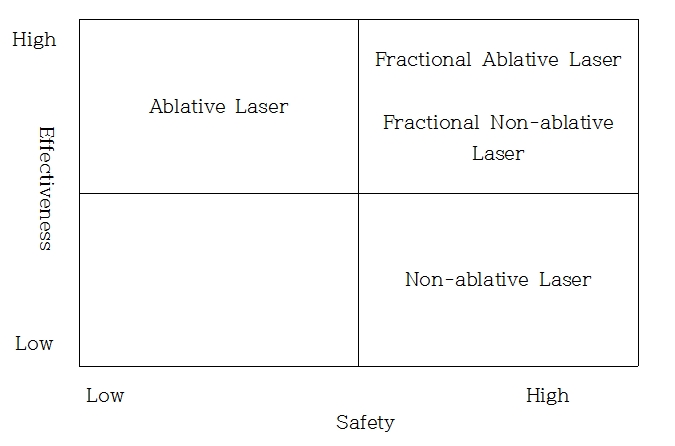From this chapter, we will look into the types and principles of lasers for skin diseases or aesthetic treatments. Lasers for skin care or disease treatment can be categorized to 4 types:
Vascular lesions
Pigmentation lesions & tattoos
Facial wrinkles or scars
Hair removal
Types of lasers used for skin rejuvenation, tightening and resurfacing, which are known to improve facial wrinkles, scars or general skin condition, and therapeutic effect and safety of each laser will be discussed. Currently available lasers are categorized to 4 types as follows, and each are described below:
[Advertisement] HELIOSⅡ/LOTUSⅡ/HYPERION – Manufacturer: LASEROPTEK(www.laseroptek.com)
Ablative systems.
Non-ablative systems.
Fractionally Non-ablative systems.
Fractionally Ablative systems.
10-1. Ablative Systems
Before the idea of Fraxel was published 8 years ago, racial wrinkles or scars were improved by Er:YAG laser or CO2 laser, which removed the epidermal and dermal layers, while inflicting thermal damage to the dermal layer, for therapeutic effect. Afterward, collagen regeneration or collagen remodeling, in the process of skin regeneration, improves facial wrinkles and scars. This method provided a much superior therapeutic effect, but clinics were reluctant to perform this method due to the high likelihood of pigmentation and scarring after the procedure (as a result of insufficient postoperative management) and longer downtime before returning to daily life. In other words, skin rejuvenation or tightening was limited in this method.
Er:YAG laser, which is capable of removing a thin skin, is basically aimed at precise removal of spots, scars or wrinkles, with minimal side effects, including pigmentation, and maximal therapeutic effect. It is not sufficient, therefore, for skin tightening or rejuvenation with enough thermal damage to the dermis. CO2 laser, which has greater thermal effect than Er:YAG lasr, may provide a greater thermal damage to the dermis, but is associated with blood coagulation and necrosis of the surrounding tissues, increasing the risk of postoperative pigmentation compared to Er:YAG laser.
10-2. Non-ablative systems
The main objectives of these devices are to minimize downtime and to not inflict a damage to the skin, while providing rejuvenation effect. When Intense Pulsed Light (IPL) was first introduced, it was expected that this one device would treat all skin diseases. IPL, which uses Xenon lamp and cut-off filter, was published at first as being capable of treating all kinds of lesions, ranging from vascular lesions to pigmentation lesions, hair removal and rejuvenation. This was because IPL emits wavelengths from about 550nm to 1100nm and was considered to replace lasers using these wavelengths. However, the effect was insignificant, because the light emitted from IPL is not well absorbed by hemoglobin, melanin and water. The most important things required for dermatological treatment are the absorption coefficient of the above mentioned 3 important absorbents and fluence. Because IPL cannot satisfy these conditions, it is used limitedly for redness, blemishes or temporary hair removal.
10-3. Fractionally Non-ablative systems
These lasers refer to all those known as Fraxel, including 1500nm Fraxel Er:Glass fiber laser, Lux1540 and 1440nm Nd:YAG affirm laser. As with IPL, Fraxel was published as being applicable to all sorts of skin lesions, especially with superior skin rejuvenation effect compared to IPL.
The idea of Fraxel is that irradiating micro-sized laser beam in equal space or random space, with the use of a scanner, leaves microscopic columns of thermal damage between undamaged skin tissues of the dermis, without inflicting an injury to the skin. In this manner, the dermis get to have thermal damage at random interval, which stimulates collagen to start the above mentioned collagen remodeling, ultimately improving wrinkles and scars and tightening the skin.
As shown in Table 10-1, the Fractional non-ablative system is superior in terms of safety (side effects or downtime), but is less effective compared to the ablative system. Therefore, the main purpose of the non-ablative system is to provide a treatment without inflicting damage to the epidermis, with less postoperative side effects, such as pigmentation and scarring, minimized downtime and therapeutic effect equal to the ablative system. For this effect, however, the thermal characteristics should be equal to those of Er:YAG laser or CO2 laser. In general, infrared light has stronger thermal characteristics with longer wavelength. 1500nm wavelength has only marginal thermal characteristics compared to these 2 types of laser. It would be rather impossible, therefore, to obtain such a therapeutic outcome.

Fig. 10-1. Comparative Safety and Effectiveness of Skin Rejuvenation Technology
10-4. Fractionally ablative systems.
Since the introduction of the idea of Fraxel, a lot of clinical results pointed out that the effect was not as excellent as that of the ablative system. The idea of Fractional ablative laser emerged in this context. In the contrary to Fraxel, the idea was not thermal damage but directly removing the dermis or epidermis layer in the form of fine columns. In this manner, the epidermis can be protected, compared to the ablative system which simply removes the epidermis and dermis, and the downtime gets shorter, without side effects. Among the most commonly used devices at the moment, Fractional Er:YAG laser and CO2 laser have become famous for their therapeutic effects from about 6 years ago, and now they are working as bridges between the two systems, by sharing the benefits of ablative laser and non-ablative laser. In short, they are recognized as devices allowing both resurfacing and rejuvenation (tightening).
- To be continued-
▶ Previous Artlcle : #7. Factors to be considered before Purchasing Dermatologic Lasers
▶ Next Artlcle : #9-1. Q-switched Laser





















